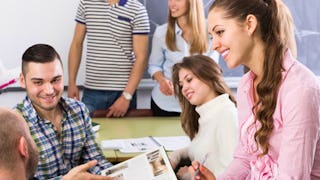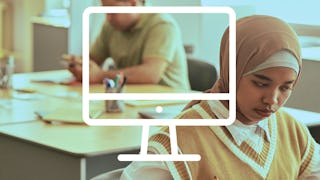This course explores ways of teaching reading skills in English as Second and Foreign Language (ESL/EFL) using a task-based approach. You will be introduced to the concept of task and the key principles of task-based language teaching (TBLT) and learning. TBLT uses communicative tasks as the key unit for creating language learning activities. You will also examine the role of reading in real-life and in second and foreign language teaching and current thinking about the interface between TBLT and second language reading. You will explore how TBLT and teaching second language reading can be successfully integrated in practice through analysing task-based reading materials. The course culminates in creating task-based materials for teaching reading in your own language teaching contexts.


Enjoy unlimited growth with a year of Coursera Plus for $199 (regularly $399). Save now.


Teaching EFL/ESL Reading: A Task Based Approach



Instructors: Dr Amos Paran
62,716 already enrolled
Included with
(657 reviews)
Skills you'll gain
Details to know

Add to your LinkedIn profile
See how employees at top companies are mastering in-demand skills

There are 7 modules in this course
Welcome to 'Teaching EFL/ESL Reading: A Task Based Approach!'.
What's included
1 video2 readings
Welcome to module 1! In this module we will be looking at some key concepts and issues that surround the role of tasks in second language learning and teaching. First, we will define what we mean by the notion of task. Then, we will consider different task types and the role of tasks in the syllabus. We will also discuss the rationale for using tasks in second language teaching, and how task-based lessons and sequences are typically organized. The module ends with an interview with Dr. Nick Andon from Kings' College London, who is an international expert on task-based language teaching.
What's included
9 videos7 readings1 peer review3 discussion prompts
Welcome to module 2! In this module we examine reading from a number of angles. We start by examining the cognitive element of reading. The second angle we examine reading from is reading as a communicative activity, and its links with communicative language teaching. We then look at reading as a strategic activity, and at the links between reading and background knowledge, and look at the way in which background knowledge is needed in order to understand three specific texts. We end by discussing ways of developing reading fluency.
What's included
7 videos10 readings1 peer review3 discussion prompts
Welcome to module 3! In this module we will be thinking about the ways in which we teach reading in the foreign and second language classroom. We start by comparing the ways in which we read outside the classroom and the ways in which we ask our learners to reading in the classroom. We think about principles for reading in the communicative language classroom and about the implications of these principles. We go on to consider the three-phase reading lesson and look closely at an example of such a lesson, and then look at other ways in which we can construct reading lessons, focusing on the way in which we can incorporate tasks into such lessons. We end with an interview with Prof. Cathie Wallace, who talks about her research into reading classrooms.
What's included
8 videos9 readings1 peer review2 discussion prompts
Welcome to module 4! In this module we will be looking at how a focus on language, such as grammar and vocabulary, can be integrated into task-based reading sequences. First, we will consider some of the options available in terms of the stages of the task-based reading lesson. Next, we will look at each stage in more detail. We will discuss the usefulness of pre-teaching vocabulary. We will examine how a focus on language can be incorporated at the while-reading stage. In particular, we will review research on two textual modification techniques, glossing and textual input enhancement. We will also reflect on ways of selecting linguistic features for language-focused work in the post-reading phase. The module ends with an interview with Dr. Parvaneh Tavakoli, a well-known researcher working on task-based language teaching.
What's included
8 videos8 readings1 peer review3 discussion prompts
Welcome to module 5! In this module we move away from the intensive teaching of reading in the classroom to working with learners on extensive reading. We define extensive reading and look at the main principles of using extensive reading. We discuss the benefits of extensive reading programmes, as well as the way in which extensive reading can be linked to task based language teaching. We end with an interview with Dr. Sam Duncan in which she talks about her experience of running a reading circle with a group of adult literacy and ESOL learners.
What's included
7 videos10 readings1 peer review4 discussion prompts
Welcome to the last module on our MOOC. In this module we will focus on the way in which we can write materials: we will think about sources for texts, about finding suitable tasks for texts, and will practice write new tasks for texts that you have already read. We will end with two interviews: one with Caroline Herring, a teacher in London who talks about materials she wrote for her own learners, and the second with Prof. Pauline Foster, who talks about reading and reading tasks.
What's included
6 videos5 readings1 peer review2 discussion prompts
Instructors



Explore more from Education
 Status: Free Trial
Status: Free TrialArizona State University
 Status: Free Trial
Status: Free TrialArizona State University
 Status: Free Trial
Status: Free TrialRice University
 Status: Free Trial
Status: Free TrialRice University
Why people choose Coursera for their career




Learner reviews
657 reviews
- 5 stars
83.43%
- 4 stars
12.15%
- 3 stars
1.97%
- 2 stars
0.60%
- 1 star
1.82%
Showing 3 of 657
Reviewed on Jul 26, 2020
This course is awesome. I enjoyed every bit of it. It was highly engaging and a good recommendation for learning how to teach reading comprehension to L2 learners. Kudo's!
Reviewed on Oct 31, 2017
I found this course absolutely fascinating. It's well designed with interesting videos which will keep you engaged. I will apply the principles to my lessonsChristopher Mo Szu Ti
Reviewed on May 11, 2023
After the course, I gained a new perspective about teaching reading. I am looking forward to use them in my teaching journey.
Frequently asked questions
To access the course materials, assignments and to earn a Certificate, you will need to purchase the Certificate experience when you enroll in a course. You can try a Free Trial instead, or apply for Financial Aid. The course may offer 'Full Course, No Certificate' instead. This option lets you see all course materials, submit required assessments, and get a final grade. This also means that you will not be able to purchase a Certificate experience.
When you purchase a Certificate you get access to all course materials, including graded assignments. Upon completing the course, your electronic Certificate will be added to your Accomplishments page - from there, you can print your Certificate or add it to your LinkedIn profile.
Yes. In select learning programs, you can apply for financial aid or a scholarship if you can’t afford the enrollment fee. If fin aid or scholarship is available for your learning program selection, you’ll find a link to apply on the description page.
More questions
Financial aid available,
¹ Some assignments in this course are AI-graded. For these assignments, your data will be used in accordance with Coursera's Privacy Notice.







